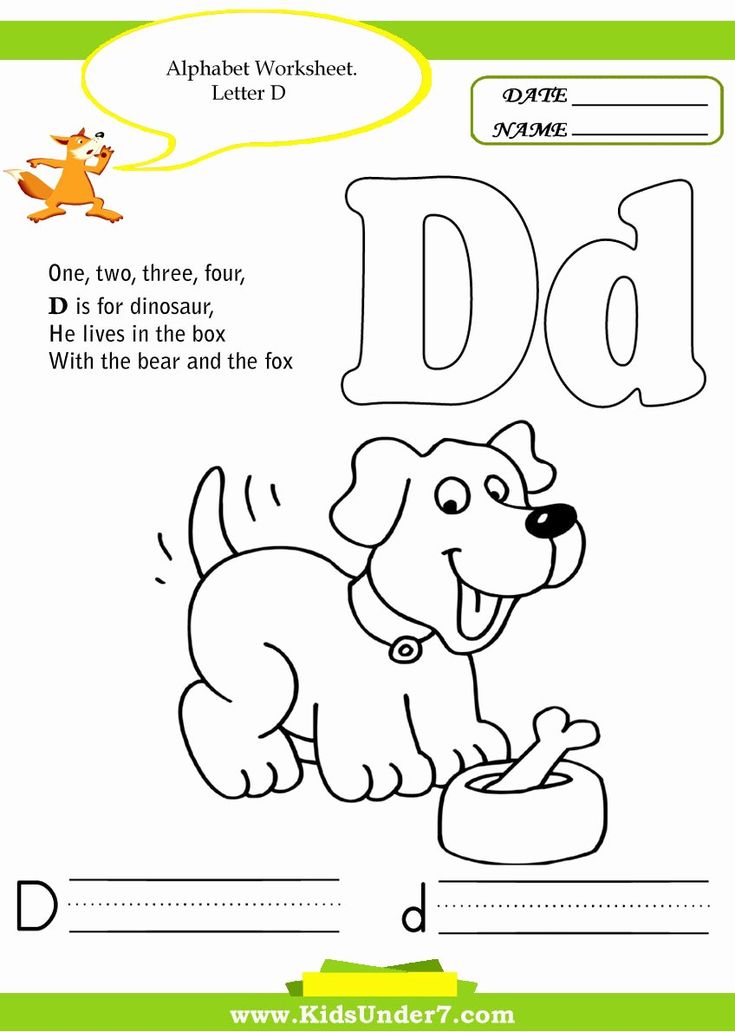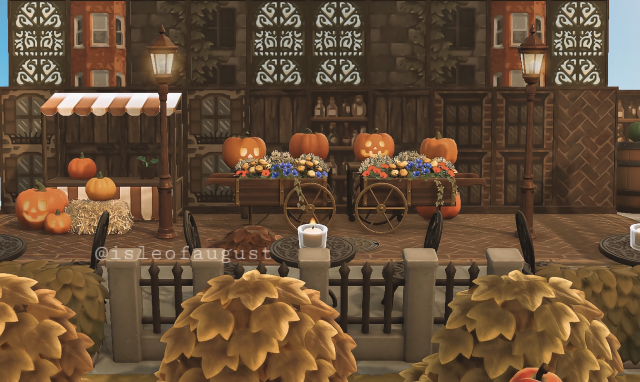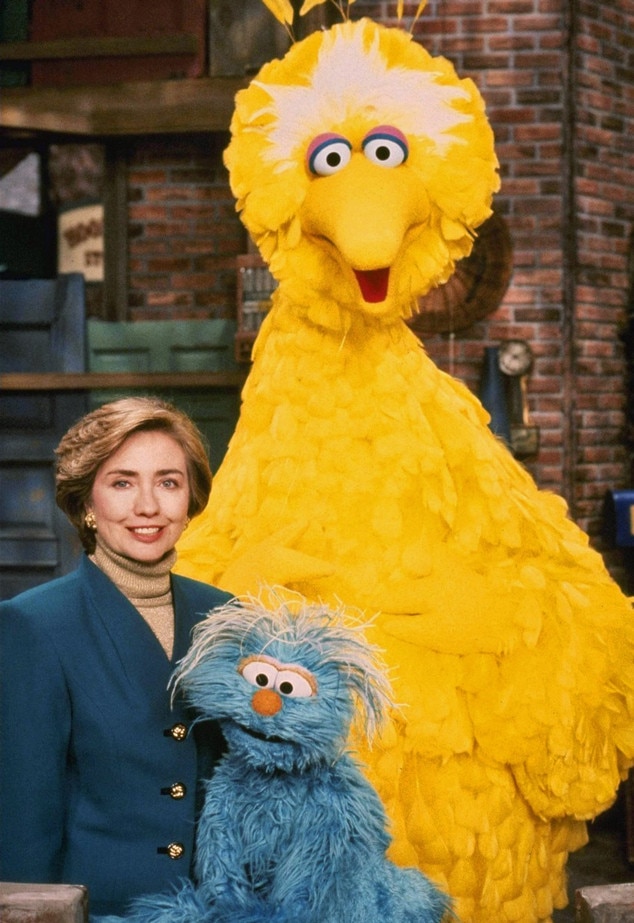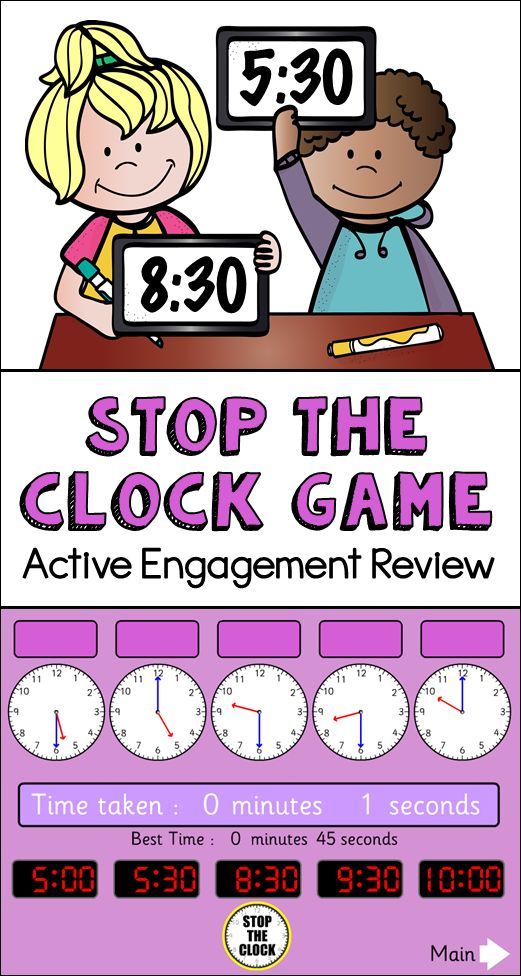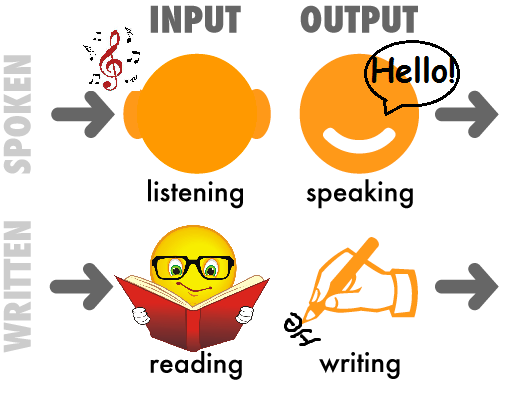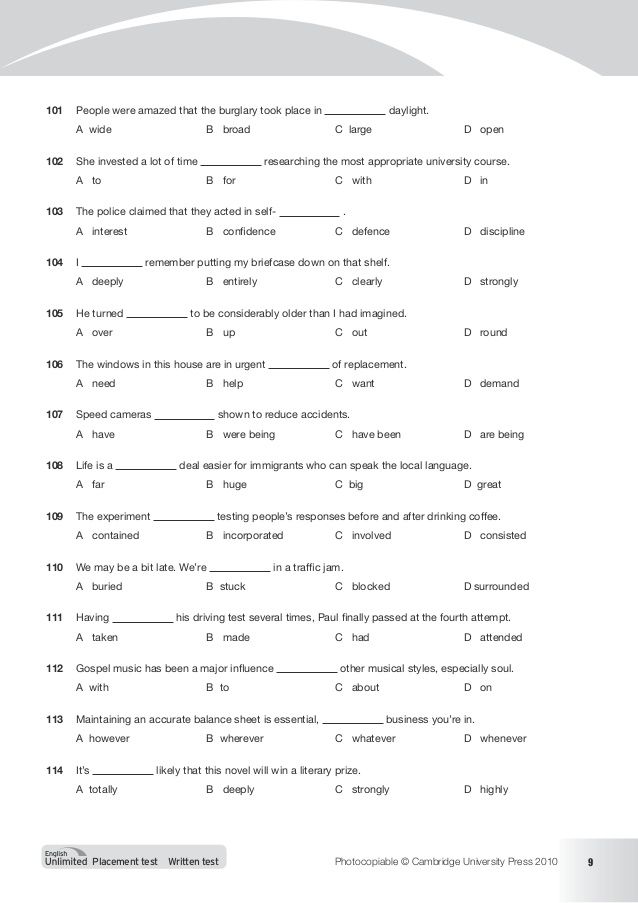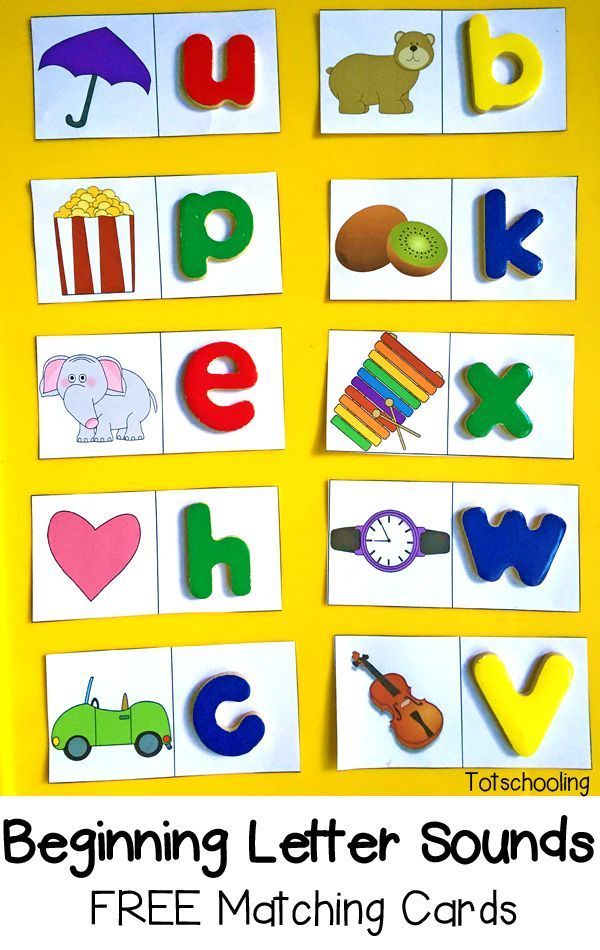Words with double consonants
Spelling Words with Double Consonants
Many words that end with a consonant (a letter that isn’t a vowel) require that the ending consonant be doubled when you add a suffix to them.
These suffixes can include –ed to form the past tense, –ing to form the present progressive tense, or –er and –est to denote comparison.
For example, “She slapped the mosquito.”
The word “slapped” is pronounced as one syllable, “slapt,” but it’s spelled like it has two syllables. The same principle applies to the word “spelled” and many others.
Do’s and Don’ts for Spelling Words with Double ConsonantsHowever, not all consonants are doubled when we add these suffixes, so you need to learn the rules for spelling words with double consonants.
When you attach a suffix to CVC words, DO double the ending consonants.Three-letter words that follow the Consonant – Vowel – Consonant (CVC) pattern always have their last consonant doubled when you add a suffix. For example:
- sip – sipped – sipping
- cap – capped – capping
- tap – tapped – tapping
- pot – potted – potting
- dip – dipped – dipping
- sit – sitting
- rob – robbing – robbed – robber
This rule also includes four-letter words that begin with blended consonants, such as pl-, sl– sh-, cl-, and bl-, among others. For example:
- slip – slipped – slipping
- drop – dropped – dropping
- crop – cropped – cropping
- clip – clipped – clipping
- clop – clopped – clopping
- stop – stopped – stopping
- grab – grabbed – grabbing
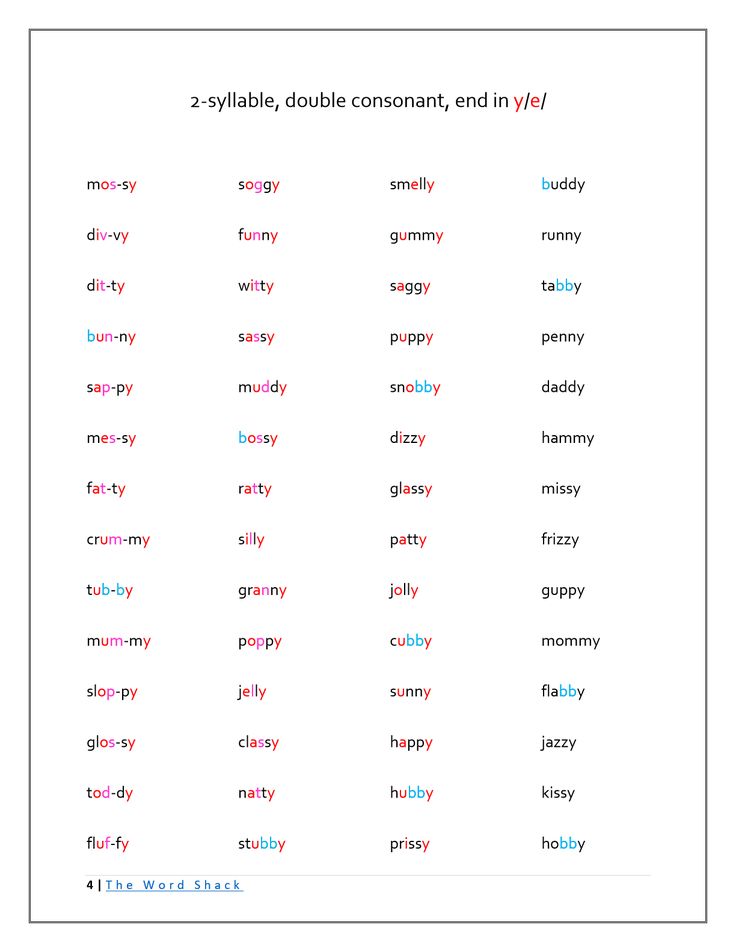
For words with more than one syllable, the key to remember is whether the last syllable is stressed or not. If the stress falls on the last syllable, double the consonant; otherwise, keep it single.
For example:
begin – beginning
The word “begin” is stressed in the last syllable; therefore you have to double the letter “n” before you add -ing.
How about for the word “visit”? The stress falls on the first syllable. This means we do not double the letter “t,” and instead, we spell it as “visited” or “visiting.”
Other examples include:
Unstressed last syllable:
- happen – happened – happening
- listen – listened – listening
- moisten – moistened – moisening
- render – rendered – rendering
Stressed last syllable:
- compel – compelled – compelling
- dispel – dispelled – dispelling
- embed – embedded – embedding
- repel – repelled – repelling
- admit – admitted – admitting
Despite this rule, though, you need to familiarize yourself with many words, because there are quite a few exceptions to this rule, such as the word “cancel.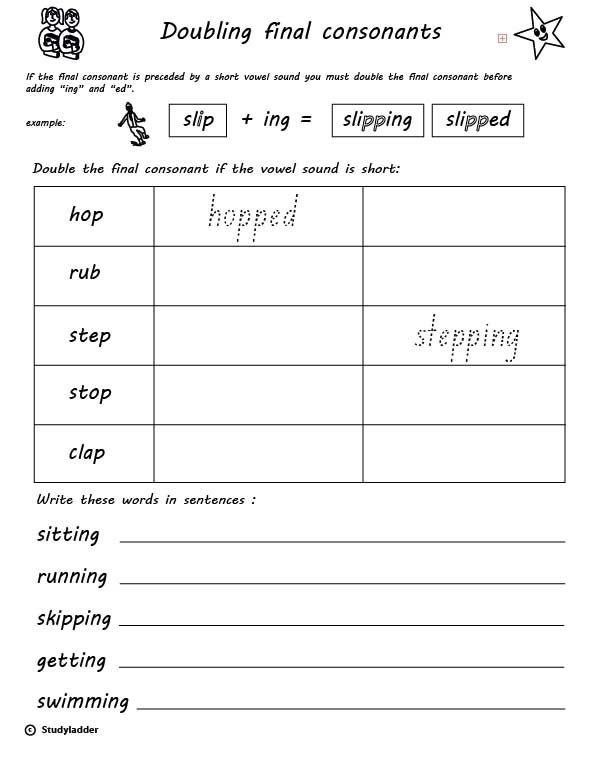 ” Cancelled and canceled are both accepted (Americans prefer canceled, while most of the rest of the world prefers cancelled).
” Cancelled and canceled are both accepted (Americans prefer canceled, while most of the rest of the world prefers cancelled).
Based on this rule, the following words, since they end in two vowels and a consonant, do not require double consonants:
- con ceal – concealed
- reveal – revealed
- unveil – unveiled
In English, a vowel sound can be short or long. For example, for the letter “a,” the short sound occurs in the word “mat,” while the long “a” sound occurs in “mate.”
Words with two syllables that feature a short vowel sound in the first syllable typically have a double consonant following it. This actually functions as a way to “protect” the short vowel sound. For example, the word “apple” contains two “p’s” and helps you determine that the word uses a short “a” sound.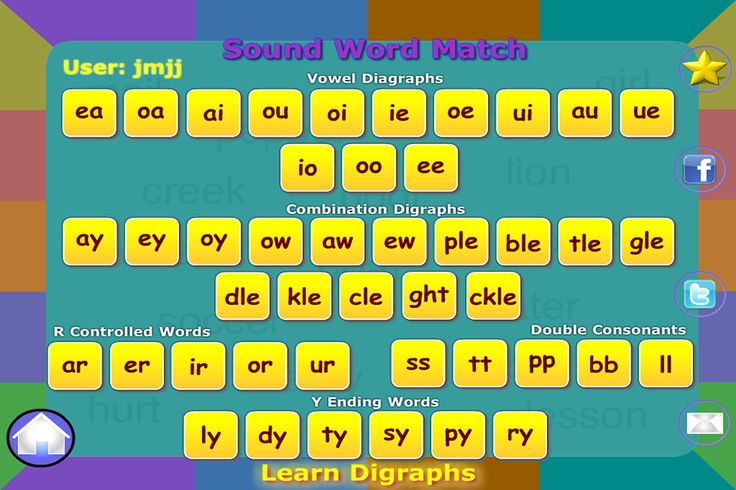 If it were spelled “aple,” it would be pronounced with a long “a” sound.
If it were spelled “aple,” it would be pronounced with a long “a” sound.
Examples of words that follow this rule are:
- matter
- batter
- butter
- bitter
- Polly
- dinner
- cottage
- drizzle
- rubber
- muffin
- coffin
If a two-syllable word has a long vowel sound in the first syllable, we don’t double the middle consonant. For example:
- spider
- minor
- bugle
- tuba
If a word ends in a consonant blend, such as –ng, –nk, –st, do not double the last consonant.
For example:
- link – linked – linking
- milk – milked – milking
- post – posted – posting
- jump – jumped – jumping
- form – formed – forming
- bond – bonded – bonding
- park – parked – parking
Check your spelling skills with this free Spelling Words with Double Consonants PDF Quiz by circling the correct spelling of the words in brackets.
- Did you hear what [happenned / happened] during Ira’s birthday party?
- He quickly [formmed / formed] his opinion of Lady Margaret.
- The father and son [bonded / bondded] over ice cream.
- The [cotage / cottage] looks very inviting.
- The government [compeled / compelled] everyone to be listed in the national ID system.
- Weren’t you [listening / listenning]?
- The three-year-old painstakingly [arranged / aranged] his toys on the shelf.
- The young mother wanted her children to appreciate their [differences / diferences].

- She’s [ridden / riden] a horse before, hasn’t she?
- “The three little kittens, they lost their [mitens / mittens], and they began to cry.”
- “[Rabbi / Rabi], did you call me?” he asked eagerly.
- “No, I don’t like spiders,” she said with a [shuder / shudder].
- The quick brown fox [jumped / jumpped] over the lazy dog.
- Do you like [aples / apples]?
- The [rabit / rabbit] nibbles on a carrot.
- Did you hear what happened during Ira’s birthday party?
- He quickly formed his opinion of Lady Margaret.
- The father and son bonded over ice cream.
- The cottage looks very inviting.
- The government compelled everyone to be listed in the national ID system.
- Weren’t you listening?
- The three-year-old painstakingly arranged his toys on the shelf.

- The young mother wanted her children to appreciate their differences.
- She’s ridden a horse before, hasn’t she?
- “The three little kittens, they lost their mittens, and they began to cry.”
- “Rabbi, did you call me?” he asked eagerly.
- “No, I don’t like spiders,” she said with a shudder.
- The quick brown fox jumped over the lazy dog.
- Do you like apples?
- The rabbit nibbles on a carrot.
Spelling rules are important to memorize if you want to avoid embarrassing mistakes. Another way to improve your spelling is to look for new words frequently and visualize them in your mind’s eye.
If you haven’t done this before, take an unfamiliar word, look at it for some time, then close your eyes and try to visualize the word. Do this with as many words as you need, and you will soon find that you can almost instinctively tell when a spelling looks “off.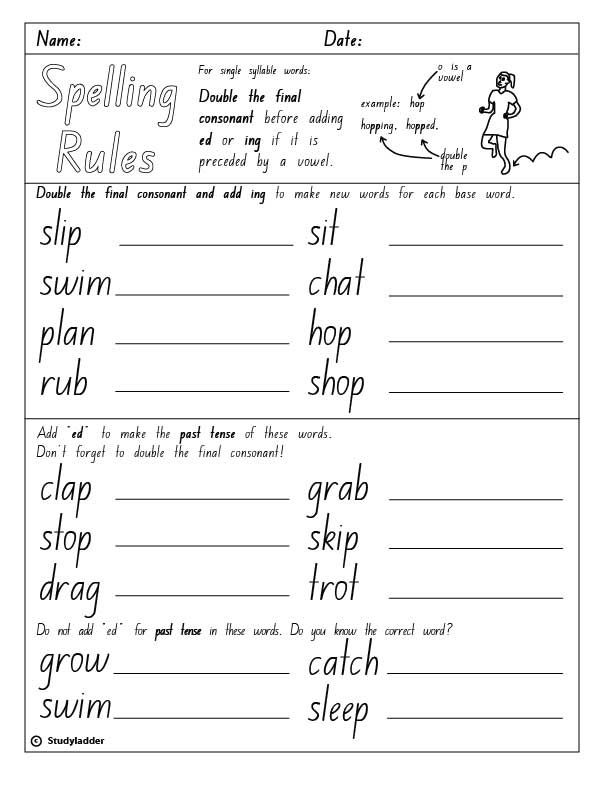 ”
”
Did you find this post helpful? Let us know in the comments below!
If you enjoyed this post, then you might also like:
- Open and Closed Compound Words: Common Examples and Rules for Spelling
- How to Study for a Spelling Test: 8 Tips for Better Results
- American vs. British Spelling: Orthography and Alternate Spellings of Common Words
- How to Spell Better Using the Secrets of Spelling Bee Winners
Yen Cabag
Yen Cabag is the Blog Writer of TCK Publishing. She is also a homeschooling mom, family coach, and speaker for the Charlotte Mason method, an educational philosophy that places great emphasis on classic literature and the masterpieces in art and music. She has also written several books, both fiction and nonfiction. Her passion is to see the next generation of children become lovers of reading and learning in the midst of short attention spans.
5 Fun Activities To Help Your Child Learn Double Consonant Words
Double consonant words can be difficult for kids to understand.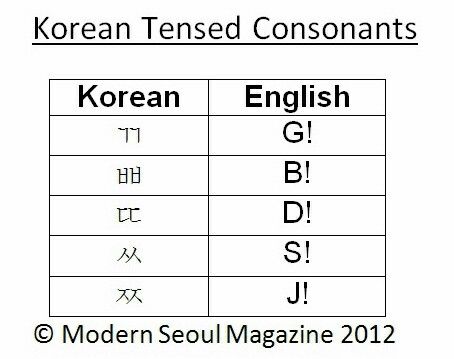 As they’re learning, they’ll need a lot of practice to help them remember to add a second consonant when appropriate.
As they’re learning, they’ll need a lot of practice to help them remember to add a second consonant when appropriate.
For example, there’s only one letter difference in the words “stared” and “starred,” but it’s an important letter. That extra “r” completely changes the meaning of the word. “Starred” is one of many double consonant words your child will learn to read and spell.
To help with this critical reading skill, we’ve put together a guide on double consonant words. In addition to information on when you need to add an extra letter, you’ll find five engaging activities to let your child learn through play.
What Are Double Consonant Words?
Before we dive into double consonant words, let’s briefly review what a consonant is.
The English language divides letters into two groups: consonants and vowels. There are 21 consonant letters — B, C, D, F, G, H, J, K, L, M, N, P, Q, R, S, T, V, W, X, Y, and Z.
Every other letter is a vowel — A, E, I, O U. (Well, sometimes Y is also a vowel, but we’ll get into that another time.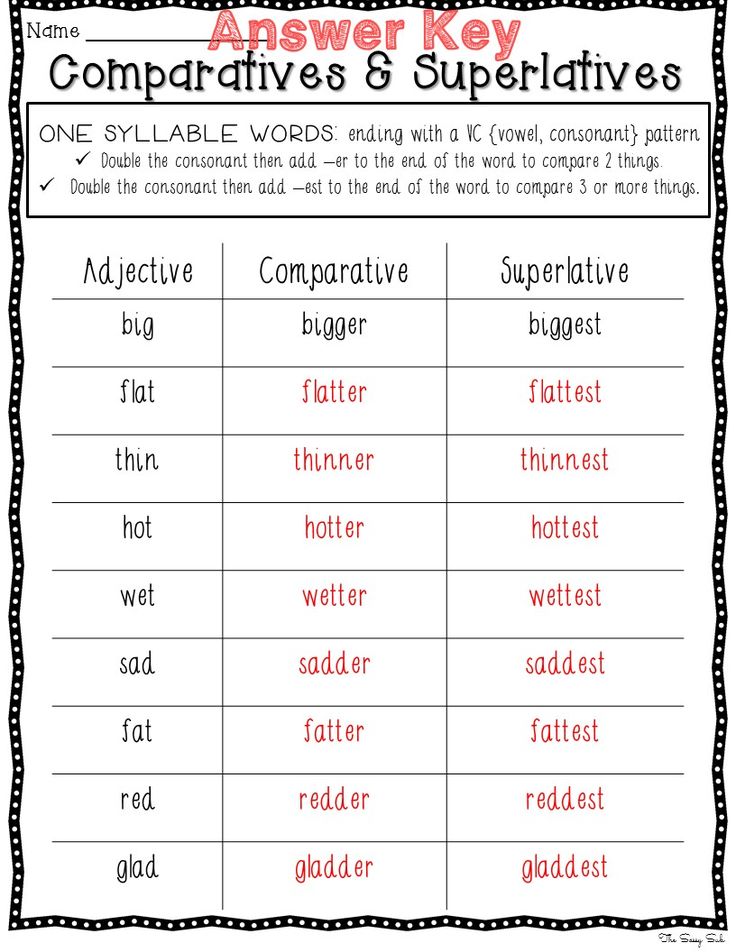 )
)
Double consonant words have two consonant letters side by side.
One spelling rule states that you’ll double the final consonant in a one-syllable word only if the word ends in one vowel followed by one consonant and you are adding an ending that begins with a vowel, like “ing” or “ed.”
For example, “clap” is a one-syllable word with a short vowel followed by one consonant as the last letter. When you add a suffix that begins with a vowel, such as “ing,” you’ll need to double that last consonant to spell the word correctly. When you do, you get the word “clapping.”
You’d also add the double consonant if you wrote the word in the past tense, “clapped.” However, the term “claps” doesn’t need an extra “p.” That’s because the suffix “s” doesn’t start with a vowel.
With that review under our belt, let’s turn to when your child should be learning this skill.
When Do Kids Learn To Read And Spell Double Consonant Words?
The ability to read and spell double consonant words typically happens around third grade. By this time, most kids have a firm understanding of the relationship between letters and sounds.
By this time, most kids have a firm understanding of the relationship between letters and sounds.
They can also read and spell different one- and two-syllable words. They’ll need to start doubling letters as they begin to read and spell longer, more complex words.
Of course, every child is different. So don’t be surprised if your child is learning this skill a bit earlier or later.
Challenges Of Learning Double Consonant Words
Learning to read and spell double consonant words can be challenging for some kids. They often can’t hear the difference between a word with a single consonant and one with a double letter.
To them, the word “stopped” likely looks like “stoped.” We know you don’t pronounce the other “p” and say, “stop-ped.” But the only way they’ll be able to tell the difference is by looking at the word and learning how double consonants function.
Additionally, you don’t double the consonant with every suffix. So trying to keep track of it all can be tricky at first.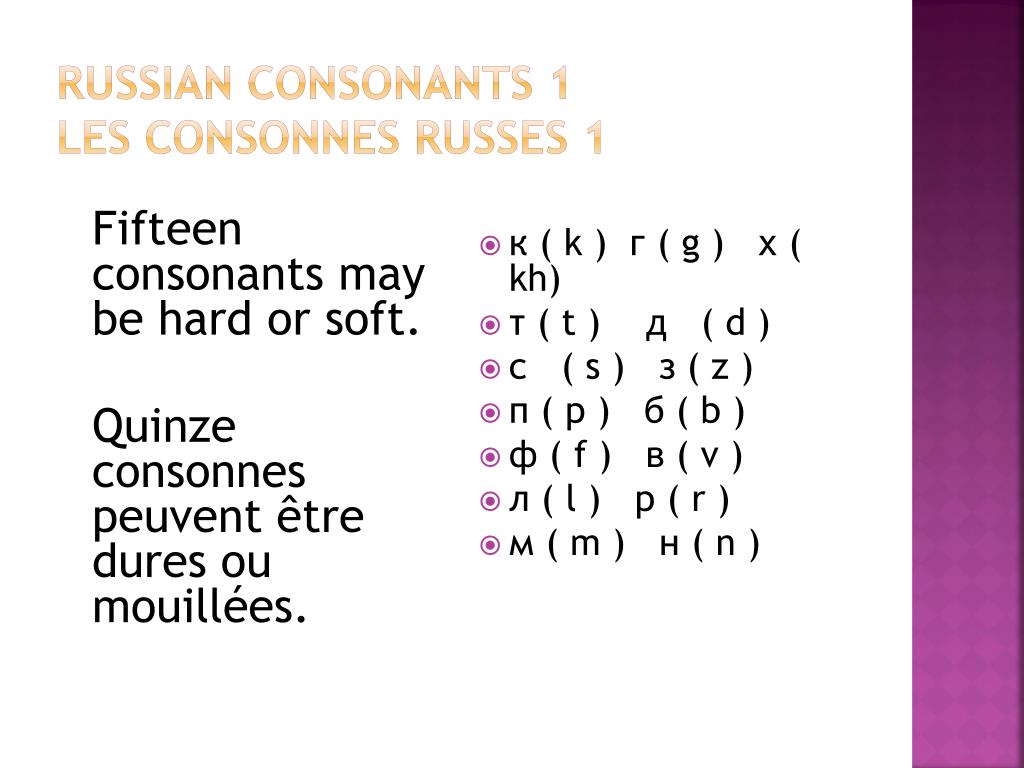
Fortunately, there are some things you can do to help your child overcome these challenges. Check out the tips below for some ideas.
Fun Double Consonant Activities
Before you can work with your child on double consonant words, you need a list of words that fit this rule.
Here are ten base words that require a second consonant when adding a suffix that starts with a vowel, such as “ed” and “ing.” You can use these words for the activities below.
- Chop
- Skid
- Plop
- Beg
- Drum
- Grin
- Split
- Bid
- Fit
- Grab
Now that you have some words to work with, let’s get into the fun!
1) Does It Need To Be Doubled?
This activity helps reinforce the rules for when words need a double consonant before adding a suffix.
What You’ll Need:
- A piece of paper
- A ruler or other straight edge
- A marker
- Small stickers
- A pencil
What To Do:
First, prepare the paper for your child. Use the ruler to divide the paper into five columns. The first four should all be the same size, and the final one should be bigger for your child to write in.
Use the ruler to divide the paper into five columns. The first four should all be the same size, and the final one should be bigger for your child to write in.
Across the top, add the following column headers:
- Base Word
- One-Syllable?
- Only One Vowel?
- Only One Ending Consonant?
- Write The Word
In the base word column, write some words from the list above. For practice, also mix in some words that don’t require a double consonant, such as:
- Jump
- Nail
- Listen
Give your child the stickers and have them read the first base word. Ask, “Is that a one-syllable word?” If it is, have them put a sticker in the corresponding column. If it’s not, ask them to leave it blank.
Continue with each of the following columns. Again, have them put a sticker in the column if the word fits the pattern. If not, they leave it blank.
Finally, ask your child to add a suffix where it’s needed. For example, if they put down three stickers in a row, they need to double the final consonant before adding the suffix, “ed.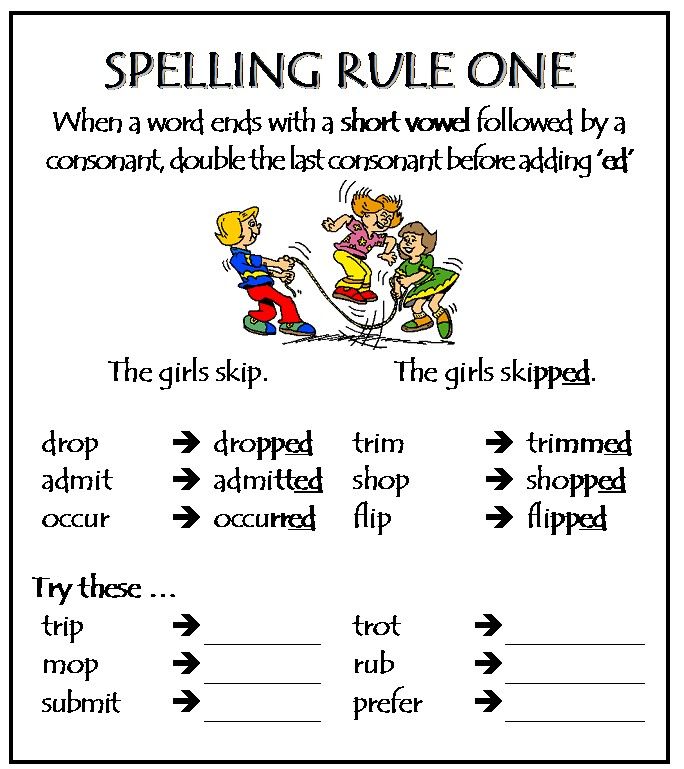 ”
”
Repeat the process with all of the base words in your chart.
The first few times you do this together, your child will likely need help, so go slowly and stop if it gets too overwhelming.
To make this a bit more fun, make a game out of it! Write five words that double and five that don’t all on individual cards. Roll the cards up so you cannot see the words and put them in a bag.
You pull out a word and fill in the chart above. If you get a double consonant word, you get a point. The first to get five points wins!
2) Double Driving
This active learning game gets your child moving around while they learn.
What You’ll Need:
- 10 Index cards
- A marker
- A toy car
What To Do:
Write a double consonant word on each index card to prepare for this game. Then, spread the cards around the room, word side up.
Hand your child a toy car. Ask them to drive around the room, picking up each word. Then, have them bring it back to you.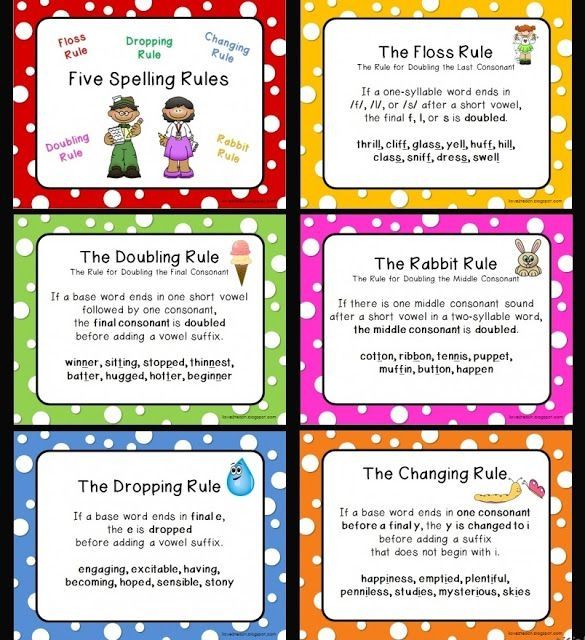 When they hand you the card, ask them to read the word.
When they hand you the card, ask them to read the word.
If they get it correct, put it in a pile. If your child misreads the word, put it back out into the room so they can try it again later in the game.
Continue sending your child out to find words until they’ve successfully read them all.
3) Shaving Cream Spelling
This spelling game is messy, but it’s sure fun!
What You’ll Need:
A can of shaving cream
A table your child can work on
What To Do:
Spray a wad of shaving cream on the table and ask your child to use their hand to spread it around. Then, give them a word that needs a double consonant and ask them to write it in the shaving cream.
If they get it correct, offer praise. If not, have your child “erase” it and try again. Continue giving them words to help reinforce the concept.
4) Find The Double Consonant Words
In this game, your child goes around the room looking for hidden double consonant words.
What You’ll Need:
Index cards with double consonant words written on them (tip: write the double consonants in different colors to set them apart)
What To Do:
Hide the index cards around the room and then ask them to search for them. Each time they find a word card, have them bring it over and read it to you.
Each time they find a word card, have them bring it over and read it to you.
After they’ve found each one, have them read through the cards once more for practice.
5) Roll The Word
Let your child use their senses and spell double consonant words with playdough.
What You’ll Need:
- Playdough
- A work surface
What To Do:
Say a word that has a double consonant before a suffix. Then, ask your child to spell it by shaping individual letters out of playdough. If they forget the double letter, ask them to look at the word again and see if they forgot anything.
Once the word is correct, have your child gather the dough together. Then, give them another one to try.
Double The Letters, Double The Fun!
The above activities can help your child become more confident in reading and writing double consonant words. With lots of practice, they’ll be less likely to struggle when they see these words in books or want to add them to a story they’re writing.
Don’t forget, every child learns at their own pace. So if your child isn’t ready for some activities, that’s OK. Just wait a bit and try again later. They’ll soon be a pro at double consonants!
In the meantime, help them keep their spelling skills sharp with the HOMER Learn & Grow app. With personalized lessons, they can practice their literacy skills at the pace they need.
Author
Double consonants. Double consonant words - Russian
§6
In Russian, words with double consonants in the root are found quite often in foreign words, as well as in some Russian words. Most often in Russian words, a doubled consonant occurs at the junction of a root and a suffix, as well as at the junction of a prefix and a root.
Double consonants in roots
Only double consonants are used in the roots of Russian words ss and lj .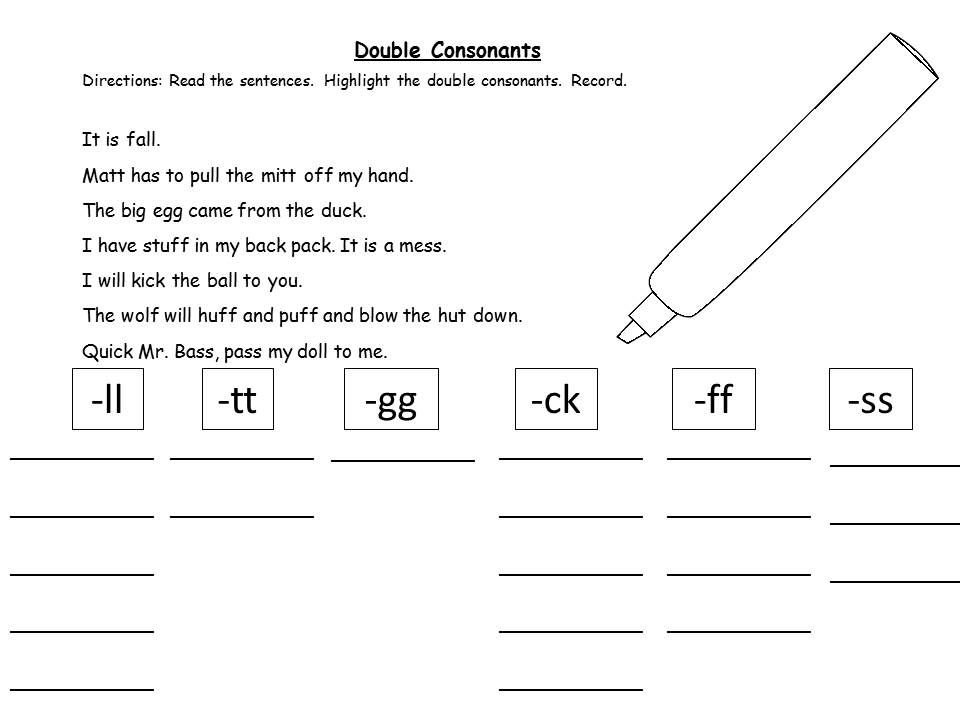 There are few such words.
There are few such words.
The letters ss are written in the word quarrel and related words formed from it, for example: to ss to shout, to ss to shout ; and also in the words Ro ss iya (from the obsolete ross ), ro ss iya, Beloru ss iya (but Rus, Belarusian ).
Letters LJ are written in words in LiveJournal and, Dro LiveJournal and, Zhu LiveJournal AT, MO LiveJournal Ewella and related related words, for example: Zhi LiveJournal ANINIA, MO LJ Evalle . Letters LiveJournal are also written in words and forms formed from the verb to burn ( tourniquet ), for example: LiveJournal 111111111111111111111111111, LJ 1111111111111111111 fj em .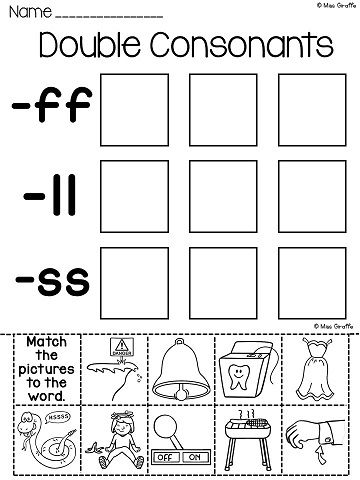
Double consonants at the junction of a prefix and a root
Double consonants in Russian words are written at the junction of a prefix and a root if the prefix ends and the root begins with the same consonant, for example: , in sz rhenium, according to dd hold, o tt excut .
Notes:
1. With the letters ss words formed from the root -count- 9 are written0012 using the prefix ras - for example: ra ss read, ra ss read . Words with the same prefix and root -th- are written with one with , for example: calculation, calculating (but countless , from without counting ).
2. Double consonants can occur in suffixes and at the junction of a root and a suffix, for example: traditional nn th, unity nn th, matro ss cue .
These cases will be considered later.
Double consonants in foreign words
Most double consonants are found in foreign words, for example: appeal , intellectual , occupant . These words, as well as words with unchecked spellings, need to be memorized. The following is a list of the most common words with double consonants.
Words with double consonants
A
- aggressor
- apparatus
- association
- allegory
- appetite
- attaché
- abstract
- artillery
- certificate
- cancel
- assistant
- attraction
- appeal
B
- ballad
- barricade
- fiction
- ballot
- pool Bulletin
G
- group
D
- discussion
- dissertation
- differentiation
AND
- illusion
- illumination
- illustration
K
- classic
- comment
- concession
- collective
- communism
- correspondent
- colloquium
- communiqué
- crystal
- column, colonnade
- compromise
- crystal but crystal
- colossus
- congress
- cross
- commission
M
- weight
- metal
- mission
O
- occupation
- opposition
- opponent
R
- parallel
- pessimism
- progress
- passive
- press
- profession
- platform
- program
R
- director
- spring
- repression
C
- symmetry
- surrogate
T
- telegram
- territory
- highway
- tennis
- terror
- troupe
- terrace
- tons, but five tons
- tunnel and tunnel
X
- hockey
C
- celluloid
- cellulose
W
- Chassis
- highway
E
- expression
- effect
Rate:
5 (4)
Share with friends
Words with double (doubled) consonants / Spelling and orthograms grades 1-4 / Reference book on the Russian language for elementary school
- Main
- Handbooks
- Primary school Russian language guide
- Spelling and spelling of grades 1-4
- Words with double (doubled) consonants
A long consonant in a word is often written using two identical consonants.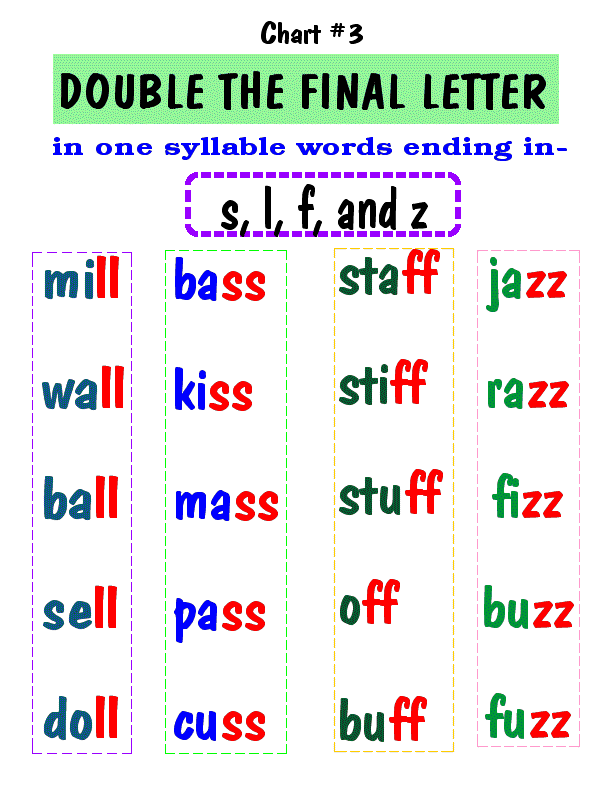 Such consonants are called double (doubled).
Such consonants are called double (doubled).
The following consonants can be double in words:
- bb - pp - Saturday, group, troupe, apparatus
- ff - differentiate
- kk - neat, accordion, hockey
- ss - profession, art, Russian
- tt - attraction, certificate
- rr - terrace, platform
- burning - buzzing, burning
- ll - collection, alley, million
- mm - grammar, kg
- nn - bath, column, lemon
Double consonants can stand:
- Burning at the beginning of a word
- In the middle of a word - worldview
- At the end of the word - kilogram
Double consonants are written at the junction of the prefix and the root : indefinite, view, support
Double consonants can be at the junction of the root and the suffix : chimney, lemon.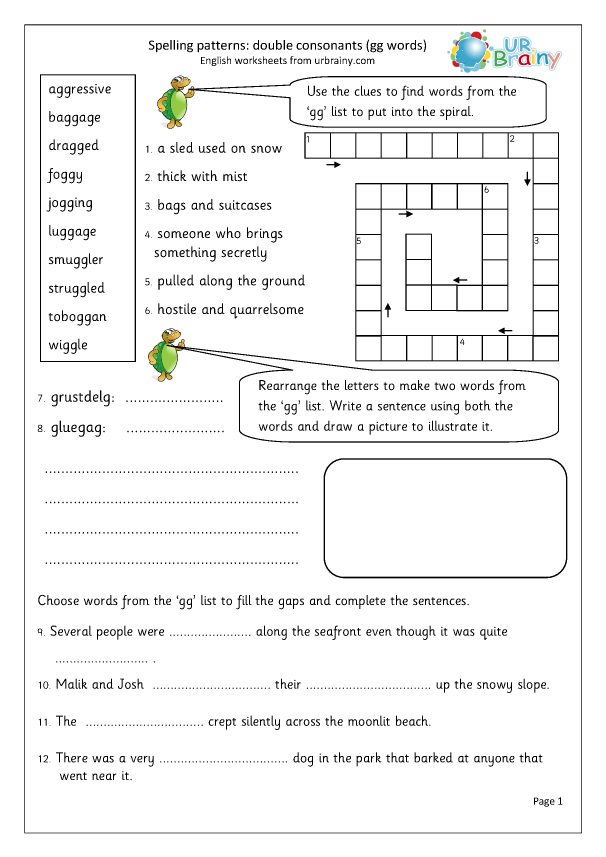
Double consonants can be located and at the root of : art, gram.
The spelling of double consonants should be memorized or, if in doubt, consult a spelling dictionary.
Usually, where a long sound is heard, double consonants are written. However, there are a number of exceptions that you need to know: gallery, imitation.
! Pay attention:
Double consonants refer to one syllable : quarrel-ra, zhu-zhzhat.
When hyphenating words with doubled consonants, these letters are separated by : Saturday, Appetit.
Share with your friends on social networks:
We advise you to see:
The use of the capital (large) letters
unstressed vowel in the root of the word
Spelling of the voiced and deaf consonants in the root of the word
The verified unpronounceable consonant in the root of the word
Words with the alternation of vowels
22 Words with alternating consonants in roots
Soft sign in words as an indicator of softness
Grammar soft sign after hissing
Separating soft and hard sign
Spelling of prefixes on -з / -с
Spelling of prefixes and prepositions
Combinations - ZhI-SHI, CHA , CHU-SCHU in different parts of the word
Letters I - Y after C
Spelling of combinations -ORO-, -OLO-, -ERE-, -ELE-.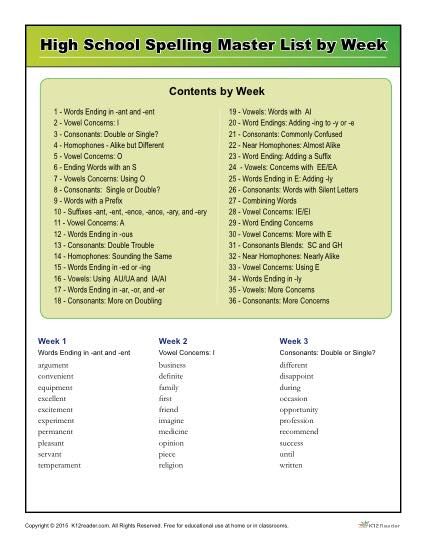
Suffixes -ENK-, -ONK- in adjectives
Vowels E, I in noun suffixes -EK-, -IK-
Spelling of suffixes -О, -А, -Е in adverbs
Vowels О, Е, Е after sibilants
Spelling of unstressed noun endings
Spelling of unstressed adjective endings
-tsya in reflexive verbs
Spelling "not" with verbs
Word hyphenation
Spelling and spelling of grades 1-4
The rule is found in the following exercises:
2 class
Exercise 221, Kanakina, Goretsky, Textbook, part 2
exercise 3, Klimanova, Babushkina, Workbook, part 1
Exercise 104, Klimanova, Babushkina, Workbook, part 1
Exercise 105, Klimanova, Babushkina, Workbook, part 1
Exercise 106, Klimanova, Babushkina, Workbook, part 1
Exercise 140, Polyakova, Textbook, part 2
Exercise 2, Buneev, Buneeva, Pronina, Textbook
exercise 3, Buneev, Buneeva, Pronina, Textbook
Exercise 25, Buneev, Buneeva, Pronina, Textbook
Exercise 34, Buneev, Buneeva, Pronina, Textbook
Grade 3
Exercise 5, Kanakina, Workbook, part 1
exercise 70, Kanakina, Workbook, part 2
Exercise 171, Kanakina, Workbook, part 2
Exercise 127, Klimanov, Babushkina, Textbook, part 2
Exercise 186, Klimanov, Babushkina, Textbook, part 2
Exercise 38, Klimanova, Babushkina, Workbook, part 2
Exercise 94, Klimanova, Babushkina, Workbook, part 2
Exercise 158, Polyakova, Textbook, part 1
Exercise 219, Polyakova, Textbook, part 1
Exercise 69, Buneev, Buneeva, Pronina, Textbook, part 1
4th class
Exercise 95, Kanakina, Goretsky, Textbook, part 1
Exercise 66, Kanakina, Workbook, part 1
Exercise 226, Kanakina, Goretsky, Textbook, part 2
Exercise 256, Kanakina, Goretsky, Textbook, part 2
Exercise 164, Kanakina, Workbook, part 2
Exercise 64, Klimanov, Babushkina, Textbook, part 1
Exercise 188, Klimanov, Babushkina, Textbook, part 1
Exercise 77, Buneev, Buneeva, Pronina, Textbook, part 1
Exercise 502, Ladyzhenskaya, Baranov, Trostentsova, Grigoryan, Kulibaba, Textbook, part 2
Exercise 692, Ladyzhenskaya, Baranov, Trostentsova, Grigoryan, Kulibaba, Textbook, part 2
5th class
Exercise 240, Ladyzhenskaya, Baranov, Trostentsova, Grigoryan, Kulibaba, Textbook, part 1
Exercise 244, Ladyzhenskaya, Baranov, Trostentsova, Grigoryan, Kulibaba, Textbook, part 1
Exercise 65, Razumovskaya, Lvova, Kapinos, Textbook
Exercise 66, Razumovskaya, Lvova, Kapinos, Textbook
Exercise 67, Razumovskaya, Lvova, Kapinos, Textbook
exercise 70, Razumovskaya, Lvova, Kapinos, Textbook
Exercise 154, Razumovskaya, Lvova, Kapinos, Textbook
Exercise 395, Razumovskaya, Lvova, Kapinos, Textbook
Exercise 748, Razumovskaya, Lvova, Kapinos, Textbook
Exercise 837, Razumovskaya, Lvova, Kapinos, Textbook
6th grade
Exercise 214, Ladyzhenskaya, Baranov, Trostentsova, Grigoryan, Kulibaba, Textbook, part 1
Exercise 248, Ladyzhenskaya, Baranov, Trostentsova, Grigoryan, Kulibaba, Textbook, part 1
Exercise 358, Ladyzhenskaya, Baranov, Trostentsova, Grigoryan, Kulibaba, Textbook, part 2
Exercise 361, Ladyzhenskaya, Baranov, Trostentsova, Grigoryan, Kulibaba, Textbook, part 2
Exercise 409, Ladyzhenskaya, Baranov, Trostentsova, Grigoryan, Kulibaba, Textbook, part 2
Exercise 439, Ladyzhenskaya, Baranov, Trostentsova, Grigoryan, Kulibaba, Textbook, part 2
Exercise 475, Ladyzhenskaya, Baranov, Trostentsova, Grigoryan, Kulibaba, Textbook, part 2
Exercise 44, Razumovskaya, Lvova, Kapinos, Textbook
Exercise 254, Razumovskaya, Lvova, Kapinos, Textbook
Exercise 312, Razumovskaya, Lvova, Kapinos, Textbook
7th grade
Exercise 125, Ladyzhenskaya, Baranov, Trostentsova, Grigoryan, Kulibaba, Aleksandrova, Textbook
Exercise 242, Ladyzhenskaya, Baranov, Trostentsova, Grigoryan, Kulibaba, Aleksandrova, Textbook
Exercise 325, Ladyzhenskaya, Baranov, Trostentsova, Grigoryan, Kulibaba, Aleksandrova, Textbook
Exercise 349, Ladyzhenskaya, Baranov, Trostentsova, Grigoryan, Kulibaba, Aleksandrova, Textbook
Exercise 366, Ladyzhenskaya, Baranov, Trostentsova, Grigoryan, Kulibaba, Aleksandrova, Textbook
Exercise 389, Ladyzhenskaya, Baranov, Trostentsova, Grigoryan, Kulibaba, Aleksandrova, Textbook
Exercise 436, Ladyzhenskaya, Baranov, Trostentsova, Grigoryan, Kulibaba, Aleksandrova, Textbook
Exercise 54, Razumovskaya, Lvova, Kapinos, Textbook
Exercise 144, Razumovskaya, Lvova, Kapinos, Textbook
Exercise 377, Razumovskaya, Lvova, Kapinos, Textbook
Grade 8
Exercise Practicum page 58, Aleksandrova, Rybchenkova, Zagorovskaya, Narushevich, Textbook
Exercise Practicum page 68, Aleksandrova, Rybchenkova, Zagorovskaya, Narushevich, Textbook
Exercise 156, Aleksandrova, Rybchenkova, Zagorovskaya, Narushevich, Textbook
Exercise 167, Aleksandrova, Rybchenkova, Zagorovskaya, Narushevich, Textbook
Exercise 179, Aleksandrova, Rybchenkova, Zagorovskaya, Narushevich, Textbook
Exercise Repetition pp.


